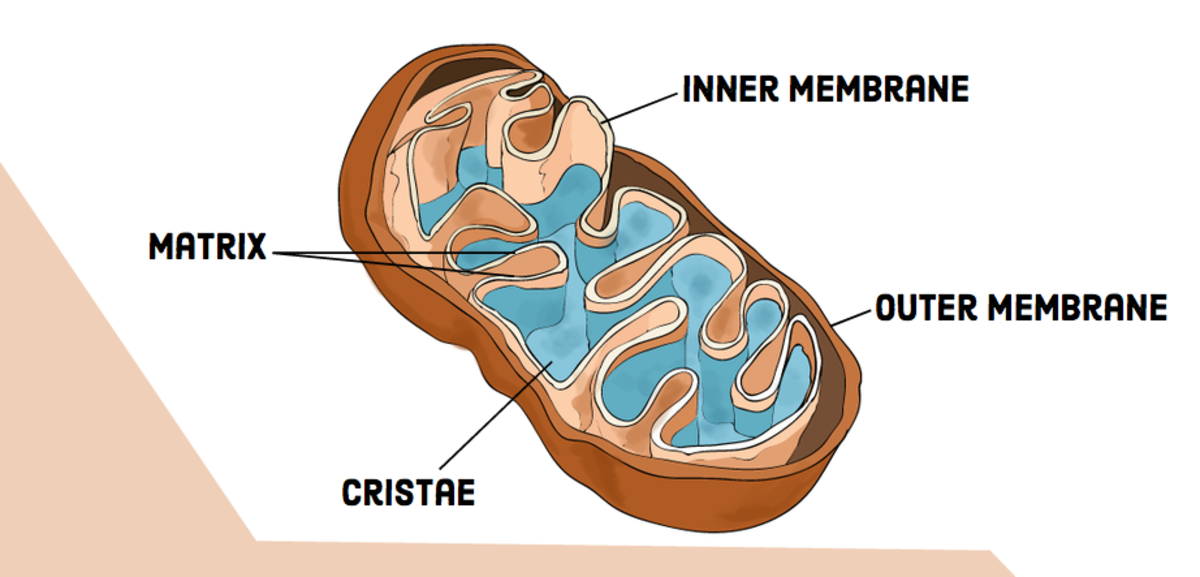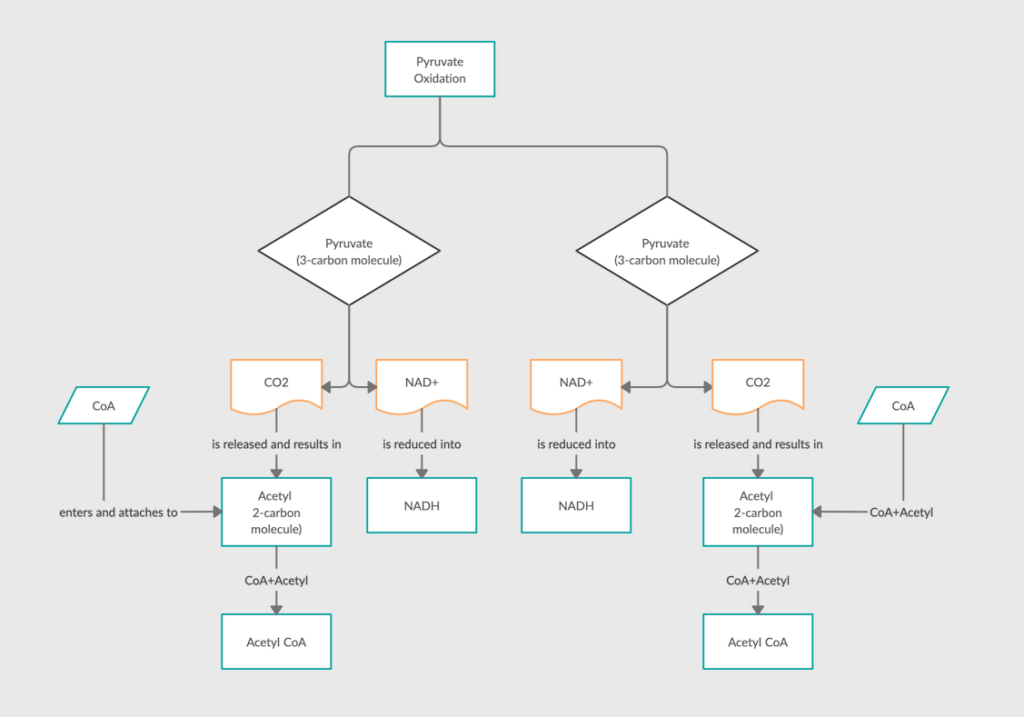Cellular respiration is an important biological process of life. It is the process of converting sugar into adenosine triphosphate, or ATP, with the use of oxygen. The product, ATP, is an important form of energy because this is what makes ATP usable. In the process of cellular respiration, carbon dioxide is released into the air as a waste material.
Mitochondrion – the powerhouse of the cell
This is the organelle or part of the cell where ATP is made by breaking down sugar in the form of glucose.

Our main focus will be on the four parts of the mitochondrion as labeled above.
Inner membrane: impermeable membrane that folds inward for more surface area
Outer membrane: selectively-permeable membrane
Matrix: inside the mitochondrion, created by the inner membrane, contains the necessary enzymes and ribosomes
Cristae: folds that contain proteins
Cellular respiration can still happen with or without oxygen. If oxygen is present, it is called aerobic respiration. However, if oxygen is absent, it is called anaerobic respiration; it can also be referred to as fermentation. A key difference between the two is also the fact that aerobic respiration is more efficient to make ATP than anaerobic respiration.
Aerobic Respiration
Aerobic respiration is the type of cellular respiration where oxygen is present. It consists of four stages: Glycolysis which converts glucose into two pyruvate molecules, Pyruvate Oxidation which is the preparatory stage for Krebs Cycle, Citric Acid Cycle (Krebs Cycle) where a large amount of NADH and FADH are produced, and Electron Transport Chain which is the most important stage because of the large ATP production.
The first stage is Glycolysis. It starts with a glucose molecule, a 6-carbon molecule, splitting into two 3-carbon molecules. This happens after two molecules of ATP are spent by attaching two phosphates at the end of the glucose molecule. After this splits, free molecules from the environment will attach to the other end of each 3-carbon molecule, resulting in two 3-carbon molecules with each having two phosphates on the ends. The four phosphates will be detached and attach to the ADP, becoming ATP. Simultaneously, NAD+ is reduced to NADH, resulting in two molecules of pyruvate.

The next stage is Pyruvate Oxidation. This stage uses two molecules of pyruvate, two molecules of coA (coenzyme A), and two molecules of NAD+ to produce two molecules of CO2, 2 molecules of acetyl coA, and two molecules of NADH. In one molecule of pyruvate, CO2 is released into the air as a waste material. Since CO2 consists of one carbon, the one molecule of pyruvate which contains three carbons, will become a 2-carbon molecule called acetyl. Simultaneously, NAD+ is reduced to NADH, and coA will enter the cycle and attach to the acetyl, producing Acetyl CoA. The products will then be doubled because there were originally two pyruvate molecules.

The next stage is the Krebs Cycle or Citric Acid Cycle. Where lots of NADH and FADH are produced to be used as electron carriers to be used in making ATP later on in the Electron Transport Chain.
This stage uses two molecules of acetyl coA, six molecules of NAD+, and two molecules of FAD+ to produce six molecules of NADH, two molecules of FADH, four molecules of CO2, and two molecules of ATP. In one molecule of acetyl coA that contains two carbons, a 4-carbon molecule called oxaloacetic acid will combine to form a 6-carbon molecule called citric acid, which explains this stage’s name. NAD+ will reduce to NADH. A molecule of CO2 will be released, twice. NAD+ will reduce to NADH. Then ADP will be converted into ATP by attaching a free phosphate to the ADP. FAD will be reduced to FADH. Another NAD molecule will be reduced to NADH. Since two molecules of acetyl coA were produced, the products will be doubled.

The Electron Transport Chain is the final stage that produces large amounts of ATP from NADH and FADH.
It uses one molecule of O2 for water production, ten molecules of NADH, and two molecules of FADH that came from the previous stages to produce water and 38 molecules of ATP. In the mitochondria, ions move via diffusion in the semi-permeable membrane, which is also called chemiosmosis, Since NADH and FADH are electron carriers, they will create a proton concentration gradient which will be pumped back inside the mitochondria, when this happens, the protein channel ATP synthase will be used, and a phosphate will be attached to ADP to become ATP. The more electrons pumped inside the ATP synthase, there will be more ATPs produced. Water is also produced.

Anaerobic Respiration
On the other hand, anaerobic respiration, or fermentation, is the type of cellular respiration where oxygen is absent. It can be Alcoholic Fermentation or Lactic Acid Fermentation.
The role of oxygen in respiration is to convert glucose into large amounts of ATP in aerobic respiration. This is also why this is the most efficient process in ATP production, with 38 ATP molecules as its maximum. Without oxygen, there are two pathways under anaerobic respiration; these are alcohol fermentation and lactic acid fermentation. In the absence of oxygen or aerobic respiration, only glycolysis occurs. In the first type of fermentation which is alcohol fermentation, pyruvate is converted into ethanol. Knowing that glycolysis produces two molecules of pyruvate and one molecule of pyruvate contains three carbon molecules, when carbon dioxide is released as a waste product, this results into 2 acetaldehyde. This 2-carbon molecule will then be converted into ethanol. In lactic acid fermentation, the molecules of pyruvate from glycolysis are converted into lactate or lactic acid when NAD+ is oxidized and turns into NADH. During this type of cellular respiration, one glucose molecule is converted to only two ATP molecules, two NADH molecules, and two pyruvate since only glycolysis occurs. Since acetaldehyde can act as an electron acceptor, the two NADH molecules can be oxidized into two NAD+ molecules.

References:
Albacete, S. (2020). FIRST STAGE OF CELLULAR RESPIRATION: Glycolysis [Video]. Schoology.
Albacete, S. (2020). SECOND STAGE OF CELLULAR RESPIRATION: Pyruvate Oxidation [Video]. Schoology.
Albacete, S. (2020). THIRD STAGE OF CELLULAR RESPIRATION: Citric Acid Cycle / Krebs Cycle [Video]. Schoology.
Albacete, S. (2020). FINAL STAGE OF CELLULAR RESPIRATION: Electron Transport Chain (ETC) [Video]. Schoology.
Biology Dictionary. (2017, April 28). Chemiosmosis https://biologydictionary.net/chemiosmosis/
Amoeba Sisters. (2018, May 1). Fermentation [Video]. Youtube. https://www.youtube.com/watch?v=YbdkbCU20_M
The Cliffside Group. (n.d.). [Mitochondria] [Photograph]. http://www.thecliffsidegroup.com/blog-in-focus/compare-and-contrast-chloroplasts-and-mitochondria